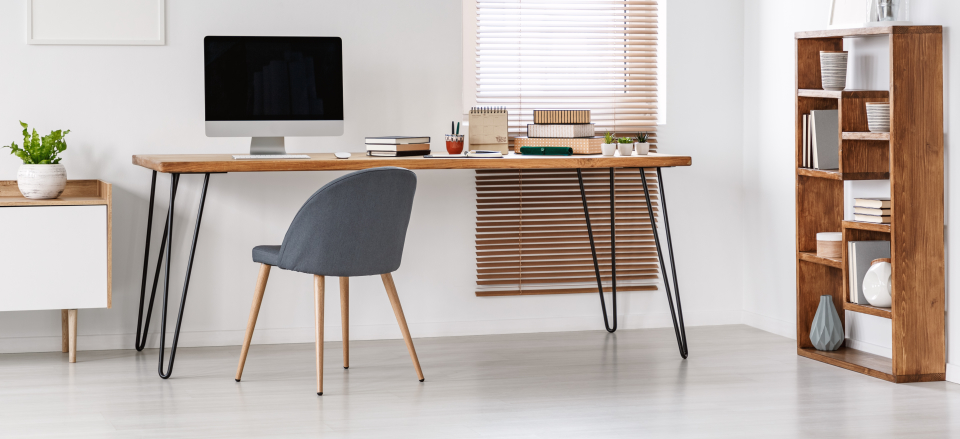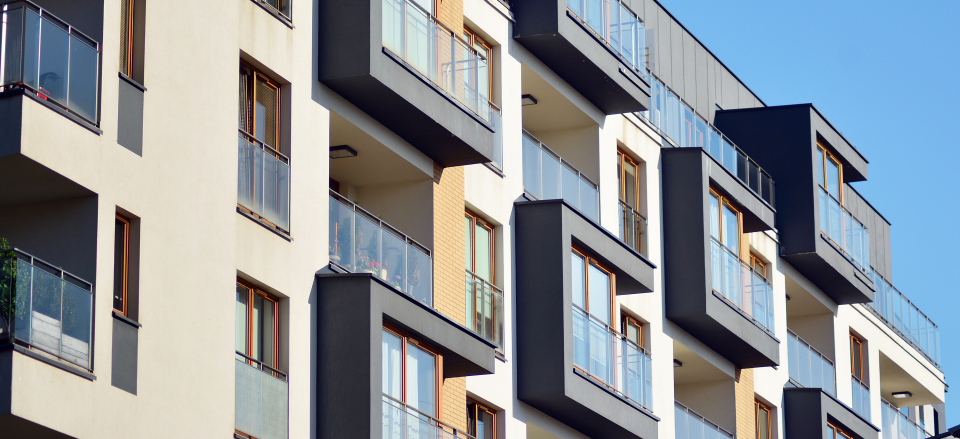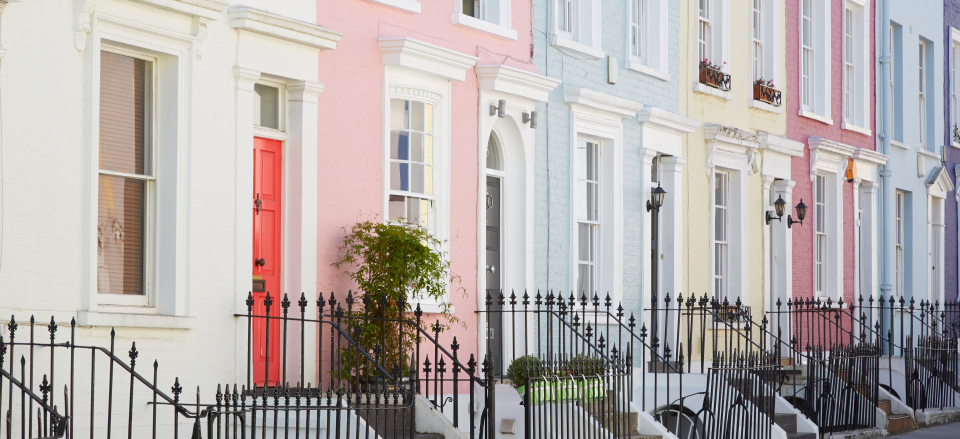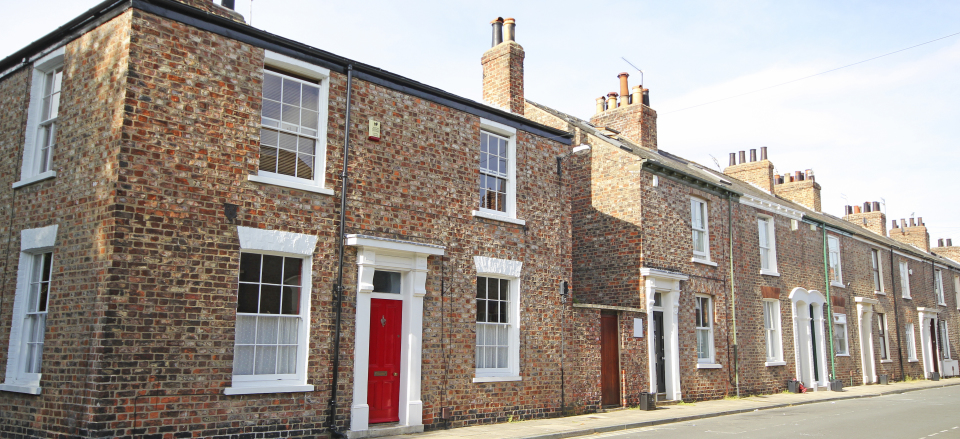Covid-19 has changed what Britons value about their homes
The pandemic and lockdown process has made more people appreciate having a study and question the practicality of open plan living, our latest research reveals.
The coronavirus pandemic and lockdown are impacting on how many of us feel about our homes, according to our latest research.
Despite working from home having become the norm for many since the first national lockdown in March, one in five Britons is not happy with their working set up.
Only 23% of those we surveyed have a dedicated study or home office, with 18% working in their living room and a further 14% working in their bedrooms.
A lack of space in which to work was the biggest gripe, with 18% of respondents complaining about being forced to share their workspace with a spouse, family member or housemate. A further 8% complained about a lack of privacy for calls and virtual meetings.
Unsurprisingly, lockdown has also changed people’s attitude towards open plan living, which has grown in popularity in recent years.
Nearly three out of 10 people said their views on open plan layouts had changed, with 11% saying they did not think they were practical in the new normal, while 33% of respondents claimed they never thought they were a good idea in the first place.
By contrast, 17% of those questioned said they now preferred the idea of open plan living, possibly because they are missing the human interaction they previously had at work.
Why is this happening?
Lockdown and the huge rise in the number of people working from home has caused Britons to re-evaluate what they want from their properties.
Features that people did not prioritise when they spent a lot of time away from their home, such as a garden or home office, have gained increased importance among Britons.
Open plan living, which operated well when a property was primarily being used during leisure time, may also have become less appealing when people are working from home for the longer-term.
Tom Parker, consumer spokesperson at Zoopla, said: “Having a home fit for the changes in our lifestyle has never been so important, particularly as many of us work from home.
“For those of us not considering moving home, there’s always scope to improve your current living space, be this painting a room to add a different feel, or zoning a space to create a space for home working.”
Who does it affect?
Despite being dissatisfied with their homeworking arrangement, only 29% of people have spent money on improving their set up, such as buying a new desk or office chair, or upgrading their wi-fi package. A lucky 14% of respondents said their employer covered the cost of improvements.
Others were more positive about working from home, with three out of 10 saying they appreciated not having the hassle and exhaustion of commuting, and 12% appreciated the money they were saving by not having to travel to and from the office.
What’s the background?
With England back in lockdown for another four weeks and other coronavirus restrictions in place in Scotland, Wales and Northern Ireland, many Britons are turning their attention to home improvements.
Upgrading interior decoration is the most popular DIY project people plan to tackle, with 32% of respondents keen to get cracking, followed by garden landscaping (15%) and kitchen renovations at (12%).
One in 10 people plan to create a home office, while 7% aim to improve their wi-fi or phone connectivity.
Fewer homeowners, however, are planning more costly home improvements, with just 5% of our respondents intending to convert their lofts and only 9% thinking of having an extension built.
Top three takeaways
-
Covid-19 and lockdown are changing what Britons value about their homes
-
One in five are still not happy with their working set up, with only 23% of people having a study or home office
-
Nearly three out of 10 people said their views on open plan layouts had changed with 11% saying they did not think they were practical in the new normal.
Mortgage choice improves for the first time in 5 months
First-time buyers have been hit by reduced mortgage availability in the wake of Covid-19, but the latest figures reveal an increase in products for borrowers with small deposits.
The number of mortgages on the market has risen for the first time since June, with choice also increasing for borrowers with small deposits.
A total of 2,404 mortgages are currently available - 145 more than in October, according to financial information group Moneyfacts.
The biggest increase was seen in mortgages for people borrowing 75% and 80% of their home’s value, with these tiers accounting for 63% of the rise.
But there was also a glimmer of hope for borrowers with small deposits who have been hit by the withdrawal of high loan-to-value mortgage products in the wake of the Covid-19 pandemic.
The latest data showed a slight improvement in mortgage availability for people with only a 10% deposit, with 56 different mortgages now on offer, up from 51 in October.
Meanwhile, 35 new mortgages were launched for those with a 15% deposit, bringing the total to 344.
But despite the improvement, the number of different mortgages available is still less than half the level seen in November last year.
Why is this happening?
The coronavirus pandemic and the economic uncertainty created by lockdown restrictions has caused lenders to review the level of risk they were prepared to take on.
Many lenders subsequently streamlined their mortgage ranges and withdrew products for borrowers with small deposits.
Despite the reimposition of lockdowns and other Covid-19 restrictions, the recent buoyancy of the housing market, combined with strong mortgage demand, appears to be tempting lenders to launch new products.
Who does it affect?
The increase in mortgage choice is good news for potential buyers as it follows five consecutive months during which lenders reduced their range.
The growth in the number of mortgages available for people with only small deposits is particularly welcome, as this sector of the market was hardest hit when lenders reviewed their ranges earlier this year.
The majority of mortgages for people borrowing 90% of their home’s value are currently being offered by small building societies, such as Penrith, Scottish, The Cumberland, and Teachers Building Societies, and may be restricted to people living in the local area.
Recently, Accord Mortgages released a series of 90% LTV ‘pulse’ deals, available for two days only, for first-time buyers. It’s latest 90% LTV deal, which ran for nine days, was available to all borrowers. Metro Bank recently relaunched its 90% deal too.
Meanwhile, start-up lender Generation Home has just launched a new-style mortgage that can be applied for by a group of up to six friends or family members.
The idea is that groups of friends who want to live together could buy a property together, or family members could assist a first-time buyer in getting on to the property ladder.
While the income of different people named on the mortgage application will be included in the calculation for how much can be borrowed, the ‘booster’, as they are known, has the choice of either contributing to regular repayments, or just being on standby in case they are needed.
What’s the background?
While mortgage availability increased in November, average mortgage rates also rose for the fourth month running.
The typical cost of a two-year fixed-rate deal edged ahead by 0.05% to 2.43%, while interest on a five-year one rose by 0.08% to 2.7% - both broadly in line with levels seen in March this year.
Meanwhile, the average time a mortgage product is available before lenders withdraw it dropped to just 28 days, the lowest level since August 2018.
This means borrowers will have to move quickly to apply for a mortgage after identifying a suitable product, as they are likely to have only a small window of time before it is withdrawn.
Top three takeaways
- The number of mortgages available has increased for the first time since June
- A total of 2,404 mortgages are now available - 145 more than in October
- The biggest increase was mortgages for people borrowing 75% and 80% of their home’s value.
Rents dropped 5% in London, but the rest of the UK showed 1.7% rental growth in 2020
Rents outside London have grown this year but they’ve dropped in the capital as Covid-19 creates a two-speed market, according to our latest Rental Market Report.
With England now in the grip of a second lockdown and restrictions in place across the rest of the UK, our latest Rental Market Report reveals Covid-19 has led to a two-speed market.
Our report shows that despite challenges caused by the impact of the pandemic in 2020, the wider UK rental market (excluding London) is resilient and has shown 1.7% annual growth in rents.
Average rents in London, however, have fallen by 5.2% over the last 12 months, reaching levels last seen in 2014.
What does the two-speed market mean?
Average UK rents outside London climbed by 0.7% in the three months to September, taking the annual growth rate to 1.7%.
Our report reveals a positive picture across most cities. Belfast and Newcastle both recorded annual rental growth of 3.5%, followed by Bristol at 3.1%. Sheffield and Glasgow followed closely behind.
However, London sits at the other end of the spectrum, with rents falling by 3.2% over the last quarter to September. It’ll take the annual fall to 5.2% by the end of December.
This two-speed market is set to be entrenched during the second lockdown in England which started in early November and is due to lift on 2 December - although an extension hasn’t been ruled out. Scotland has a five-tier restriction system in place and Wales recently emerged from a two-week “firebreak” lockdown.
What is driving rental growth?
A mismatch between tenant demand and the number of rental homes on the market is underpinning rental growth.
While renter appetite to move home has levelled off since early summer when the first lockdown ended, it’s still 20% higher than this time last year.
Stricter lending as a result of the pandemic is forcing many aspiring first-time buyers to put their home-ownership plans on hold and remain in the rental market for longer, supporting overall demand.
With universities remaining open despite the impact of Covid-19, the annual influx of students to college in the autumn will also have boosted rental demand.
Against this backdrop, the number of homes available to rent has been constrained, with investment levels dropping since the 3% stamp duty surcharge was introduced in 2016 for those buying an additional home.
What’s the regional picture like?
The strongest rental growth is in the North East, where annual rental growth is up 3.2% in the year to September.
In the North East, rental demand was 54% higher in the three months to September than the average in previous years, while supply is down 9% compared to the typical levels seen in the same three months over the past three years.
Rental growth is in positive territory in all other UK regions outside London, except Scotland and the West Midlands which have other factors affecting the dynamics of the market.
In Edinburgh, a 1.6% annual fall in rents reflects muted tourism and the shift from short-lets to long-lets, while the Aberdeen market has been affected by the North Sea energy industry.
Manchester and Birmingham have just dipped into negative territory, at -0.1% and -0.5% respectively. There are larger annual rental declines in Coventry (down 2.5%) and Reading (down 1.8%) as some cities are hit by the impact of people working from home.
What about London?
The pandemic has had a major impact on London’s rental market, with rental falls reflecting changing work and commute patterns as well as muted tourism.
Like any housing market, London’s is very localised.
The move towards working from home has particularly hit central London, where rental properties normally used by workers for part of the week are coming back to the market.
On top of this, restricted tourism during the summer and autumn has impacted the short-term rental market, with many landlords now offering long-term rentals instead.
However, rental demand is stronger in outer London boroughs where rentals tend to offer more space for the money and are more likely to come with gardens.
What impact has the first lockdown had?
The first lockdown led many renters, just like buyers, to reassess their home and lifestyle. As a result, rented houses are now being snapped up more quickly than flats in some areas. This suggests, perhaps unsurprisingly, additional space, often with a garden, is becoming more important to home-movers.
This trend is reflected in our data, which reveals that the most popular search terms are:
-
gardens
-
parking
-
garage
-
balcony
-
pets.
The timeline of renting a property has also shortened. The time it takes to rent a house and a flat in the UK, on average, is 16 days and 18 days respectively. This is down from 20 days last year for both types of property.
What’s the outlook for the months ahead?
The two-speed rental market in the UK is here to stay for the coming months, with restrictions set to exacerbate some of the trends that have emerged from previous lockdowns.
And moving into next year, the supply of rental homes in large cities could catch up with demand, limiting the scope for further rental growth.
However, earnings growth is expected to pick up again in 2021, which could pave the way for rents to increase, especially if office working becomes the norm again.
Head of research here said: "The split in the rental market caused by Covid-19 has now crystallised and we are seeing the two-speed market firmly entrenched.
"For most of the UK, the demand/supply gap is underpinning moderate levels of rental growth. We haven’t seen the exodus of students from cities and, as more people are staying in the rental market given the squeeze on mortgage lending, higher levels of demand will continue to underpin rents.
"At the same time, however, muted earnings growth will start to limit the headroom for rental growth in some markets.”
"The search for additional space, both indoor and outdoor, within the rental sector is also set to continue as the country goes through additional periods of lockdown."
Mortgage approvals soared to a 13-year high in September
The stamp duty holiday is continuing to drive high levels of buyer demand. But with England in lockdown again, will this trend continue?
Mortgage approvals for house purchases soared to a 13-year high in September as the rush to buy a home in time to benefit from the stamp duty holiday continued.
A total of 91,500 mortgages were given the green light in September, the highest level since September 2007.
The numbers edged well above August’s tally of 84,700 approvals.
The stampede to buy homes is being driven by a combination of the government’s stamp duty holiday and people reassessing their housing needs following the first coronavirus lockdown.
The high level of demand is reflected in our latest house price index, which found that the pipeline for sales was 53% bigger in October than during the same month last year.
Why is this happening?
September is traditionally a busy month as the property market enjoys an autumn bounce, but in 2020 it has shown higher activity than usual.
The strong level of pipeline sales in part reflects demand that built up during the first national lockdown continuing to work its way through the system, while activity is also being driven by the stamp duty holiday on homes costing up to £500,000.
In addition, the pandemic has caused people to reassess their housing needs, particularly with the threat of further lockdowns looming, creates additional demand.
Who does it affect?
With the stamp duty holiday due to end on March 31, buyers who want to take advantage of it need to start house hunting straight away.
It typically takes around 100 days from an offer being accepted to a transaction being legally completed.
But the current high volume of sales going through is expected to create delays in the conveyancing process, while national lockdowns such as the ones currently imposed on England and Wales could slow things down further.
We estimate that only 54% of sales agreed in January will have completed by the end of March, compared with 92% of those agreed in November.
At the same time, the number of mortgage products available has halved during the past year, with just a handful of deals remaining for people with a 5% deposit and only around 50 for those with a 10% one, according to Moneyfacts.
It is not only those borrowing a high proportion of the value of their homes that are being hit, with mortgage choice falling in all but two loan-to-value brackets, including the 60% one.
There are also reports of a rise in applications being rejected, particularly for first-time buyers, as lenders become more risk-averse.
Finally, the high levels of demand mean buyers face increased competition for homes that are on the market, with many people chasing properties with the same features, such as large gardens.
What’s the background?
Going forward, buyer appetite in some areas is expected to begin to slow down as the recession and rising unemployment take their toll.
Richard Donnell, our research and insight director, said: “The strength of the market nationally is masking weakness in parts of the market where sales are slowing in areas where households are typically on lower incomes and more sensitive to economic uncertainty and more restricted credit availability.
“This market polarisation is set to become a growing feature of the market as we move in 2021.”
Top three takeaways
-
Mortgage approvals for house purchase soared to a 13-year high in September as the rush to buy a home continued
-
A total of 91,500 mortgages got the green light during the month, the highest level since September 2007
-
The stampede to buy homes is being driven by a combination of the government’s stamp duty holiday and people reassessing their housing needs following coronavirus lockdowns.




